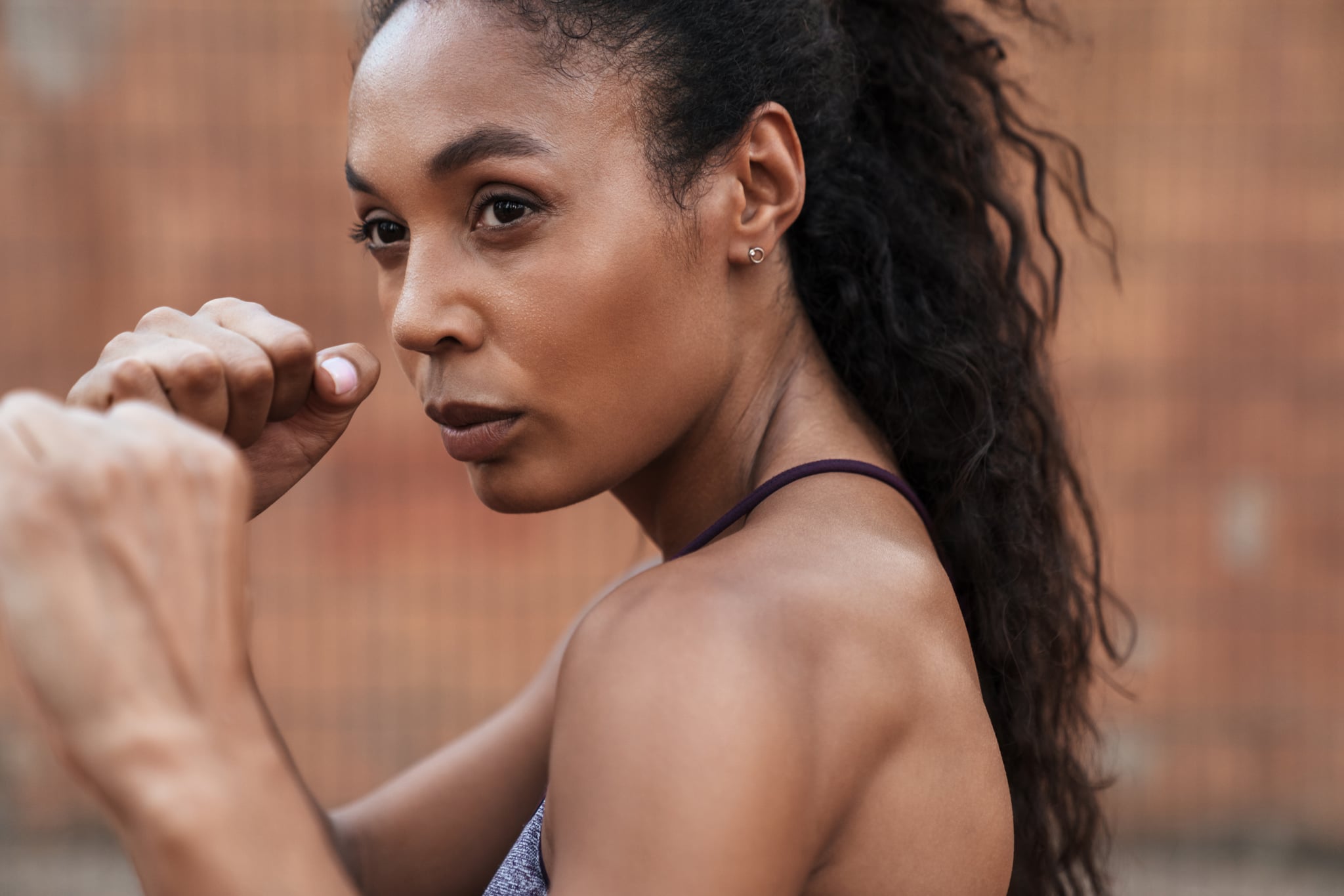
In case you’re like me and are a little tired of streaming the same old workout classes day in and out, look no further. I decided to diversify my workouts, lace up my UA Project Rock 2 Training Shoes ($140), and try a total shoulder-and-back workout straight from a sport I’ve never even attempted until now: boxing.
“Boxing is a total body workout. By even just shadowboxing, you are working your upper body, core, legs, and cardiovascular system,” explained ACE-Certified Trainer at TITLE Boxing Club-Lincoln Park in Chicago Courtney Belcastro. “Additionally, boxing can be looked at as a type of HIIT training, allowing you to maximize that metabolic calorie burn that helps you torch fat and build a strong cardiovascular system.” What’s more, it’s rather low-impact, making it a great option for at-home workouts.
Total boxing newbie like me? No problem. Belcastro shared some quick tips for getting started.
The stance
“To set up your boxing stance, stand with your feet slightly wider than shoulder-width apart — about the width you would be in to do a bodyweight squat,” said Belcastro. “For right-handed boxers, your boxing stance should follow the ‘orthodox’ set up, with your left foot forward and your right foot stepped back without losing the width of your starting position (that bodyweight squat position). Your left foot should be at 12 o’clock and your right foot should be at 3 o’clock, she explained. Now for all those lefties, your stance should follow the “southpaw” set up, said Belcastro. This means your right foot is forward and your left foot is back, aka your left foot is at 12 o’clock and your right foot at 9 o’clock.
Just remember: everything in boxing starts from the ground up. This means your knees should be bent, and your hips should move every time your hands move to throw a punch, said Belcastro. “This will help you use your whole body to pack some power in each punch and get the most out of the workout.”
The hands
“Your hands are important, as they are delivering the punches!” said Belcastro. She explained it’s crucial to keep your hands up in between your cheekbones and chin, with your elbows next to your ribcage as if you’re “protecting your face.”
No matter whether you’re a leftie or a righty, the front foot of your stance aligns with your lead hand, which will be the hand that throws the jab, lead hook, and lead uppercut. The back foot of your stance, should be your dominant or rear hand, which will throw the cross, rear hook, and rear uppercut, added Belcastro. (More on the vocab ahead!) Right-handed boxers’ lead hand is their left, while their rear hand is their right.
Boxing also makes use of the defensive roll. “You can roll two directions: to your right, or to your left,” said Belcastro. “On the roll, think about bending your knees and making a ‘U’ shape with your head in the direction you are trying to go.” Think of it as if you are trying to duck under a wire to get to the other side, she added.
Pro tip: If you see a defensive roll in the middle of a boxing combination, you roll in the direction of your next punch, said Belcastro. For example: If a cross is coming after a roll and you are in an orthodox stance, you should be rolling to the right to set up that cross.
The moves:
- Jab: A jab is a punch from your lead hand straight across.
- Cross: A cross is done with the rear hand and goes across the fighter’s body.
- Hook: A hook is thrown with the lead hand and in a semicircular pattern. Lead with your front hand, and bring your elbow up to rotate to the front side of your body. Think about making contact with the side of your opponent’s head or chin! This can be thrown with either hand.
- Uppercut: An uppercut is thrown in an upward fashion, right up the middle of a fighter’s guard. Think about making contact with your opponent’s chin here. Assume a crouched position, with your hands up as you twist your upper torso and extend your hand out. This can be thrown with either hand.
The workout: 3 three-minute rounds with a 30-second active rest in between rounds
Optional challenge: If you have them, use one- to three- pound dumbbells while punching to add some additional resistance and upper body burn.
Round 1: Basic combinations (perform each for 30 seconds to total three minutes)
- Jab-Cross
- Jab-Jab-Cross
- Non-Stop Speed Jab-Cross (consecutive punches as fast as you can)
- Jab-Cross-Lead Hook
- Jab-Cross-Lead Hook-Rear Uppercut
- Non-stop Speed Jab-Cross
- Active rest: complete 30 seconds of push-ups
Round 2: Combinations and defense (perform each for 30 seconds to total three minutes)
- Jab-Cross-Roll-Cross-Lead Hook
- Lead Uppercut-Rear Uppercut-Lead Hook-Roll-Lead Hook
- Non-stop Speed Uppercuts (Consecutive punches as fast as you can)
- Lead Uppercut-Rear Uppercut-Lead Hook-Roll-Lead Hook
- Jab-Cross-Roll-Roll-Lead Hook-Rear Hook
- Non-stop Alternating Hooks (Lead Hook-Rear Hook)
- Active rest: complete 30 seconds of squat jumps
Round 3: Burnout round (as many rounds as possible for three minutes)
- 30 Alternating Jab-Crosses
- 20 Alternating Uppercuts
- 10 Alternating Hooks
- 2 Burpees
- Active rest: hold a plank for 30 seconds
